tow Citroen C4 CACTUS 2015 1.G Owner's Guide
[x] Cancel search | Manufacturer: CITROEN, Model Year: 2015, Model line: C4 CACTUS, Model: Citroen C4 CACTUS 2015 1.GPages: 326, PDF Size: 8.56 MB
Page 137 of 326
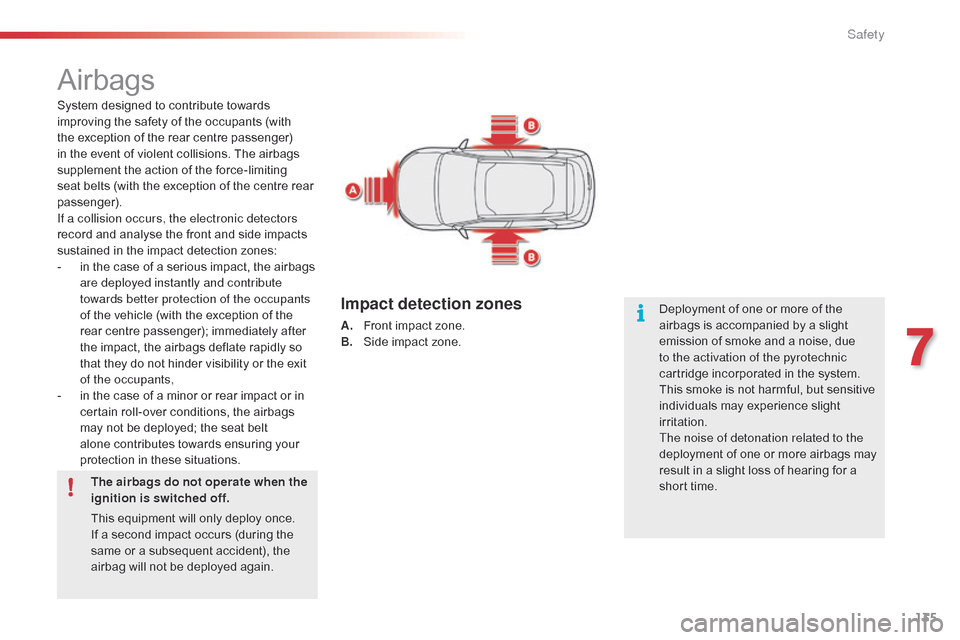
135
C4-cactus_en_Chap07_securite_ed02-2014
Airbags
System designed to contribute towards improving the safety of the occupants (with
t
he exception of the rear centre passenger)
i
n the event of violent collisions. The airbags
s
upplement the action of the force-limiting
s
eat belts (with the exception of the centre rear
p
assenger).
If a collision occurs, the electronic detectors
record
and analyse the front and side impacts
s
ustained in the impact detection zones:
-
i
n the case of a serious impact, the airbags
a
re deployed instantly and contribute
towards better protection of the occupants
of
the vehicle (with the exception of the
r
ear centre passenger); immediately after
t
he impact, the airbags deflate rapidly so
t
hat they do not hinder visibility or the exit
o
f the occupants,
-
i
n the case of a minor or rear impact or in
c
ertain roll-over conditions, the airbags
m
ay not be deployed; the seat belt
a
lone contributes towards ensuring your
p
rotection in these situations.
The airbags do not operate when the
ignition is switched off.
This
equipment will only deploy once.
I
f a second impact occurs (during the
s
ame or a subsequent accident), the
a
irbag will not be deployed again. Deployment
of one or more of the
a
irbags is accompanied by a slight
e
mission of smoke and a noise, due
t
o the activation of the pyrotechnic
cartridge
incorporated in the system.
This
smoke is not harmful, but sensitive
i
ndividuals may experience slight
ir
ritation.
The noise of detonation related to the
deployment
of one or more airbags may
r
esult in a slight loss of hearing for a
s
hort time.
Impact detection zones
A. Front impact zone.
B. S ide impact zone.
7
Safety
Page 141 of 326
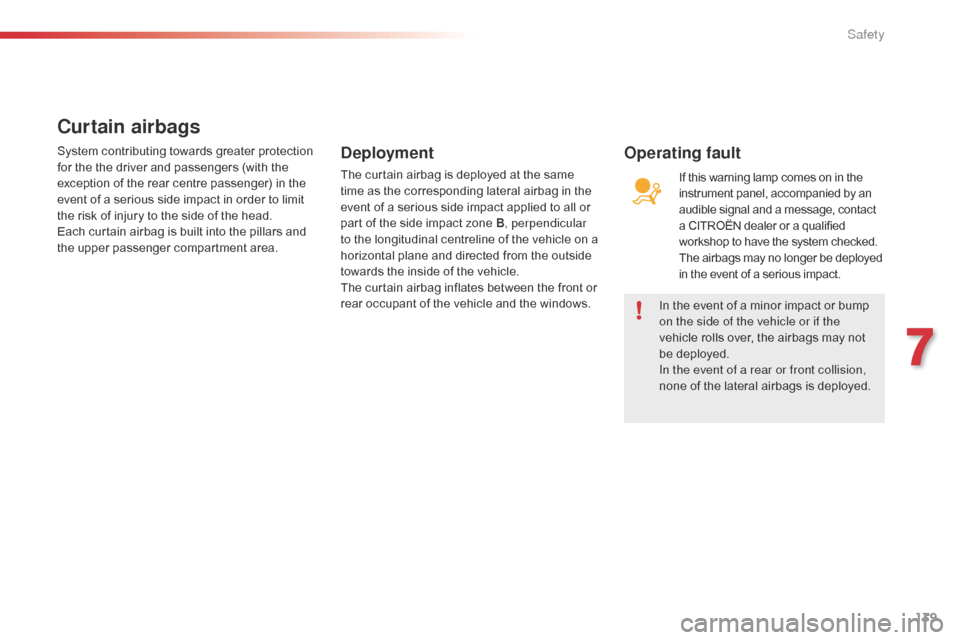
139
C4-cactus_en_Chap07_securite_ed02-2014
In the event of a minor impact or bump on the side of the vehicle or if the
vehicle
rolls over, the airbags may not
b
e deployed.
In the event of a rear or front collision,
none
of the lateral airbags is deployed.
System
contributing
towards
greater
protection
f
or
the
the
driver
and
passengers
(with
the
e
xception
of
the
rear
centre
passenger)
in
the
e
vent
of
a
serious
side
impact
in
order
to
limit
t
he
risk
of
injury
to
the
side
of
the
head.
Each
curtain
airbag
is
built
into
the
pillars
and
t
he
upper
passenger
compartment
area.
Curtain airbags
Deployment
The curtain airbag is deployed at the same t
ime as the corresponding lateral airbag in the
e
vent of a serious side impact applied to all or
p
art of the side impact zone B, perpendicular
to
the longitudinal centreline of the vehicle on a
h
orizontal plane and directed from the outside
t
owards the inside of the vehicle.
The
curtain airbag inflates between the front or
r
ear occupant of the vehicle and the windows.If
this warning lamp comes on in the i
nstrument panel, accompanied by an
a
udible signal and a message, contact
a
CITROËN dealer or a qualified
w
orkshop to have the system checked.
T
he airbags may no longer be deployed
i
n the event of a serious impact.
Operating fault
7
Safety
Page 151 of 326
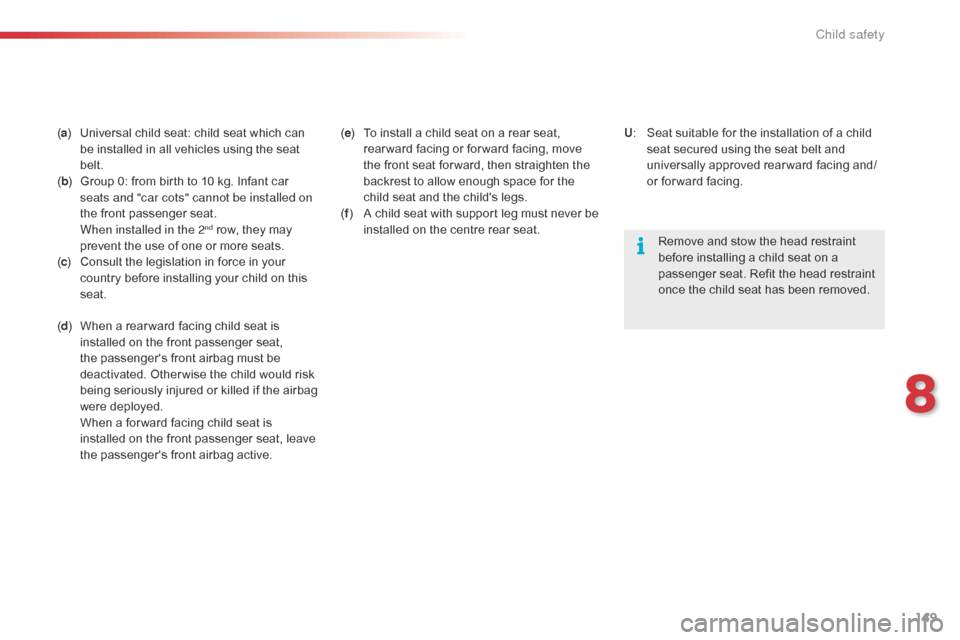
149
C4-cactus_en_Chap08_securite-enfants_ed02-2014
(a ) Universal child seat: child seat which can b
e installed in all vehicles using the seat
bel
t.
( b )
G
roup 0: from birth to 10 kg. Infant car
s
eats and "car cots" cannot be installed on
the
f
ront
p
assenger
sea
t.
W
hen installed in the 2
nd row, they may p
revent
the
use
of
one
or more seats.
( c )
C
onsult
the
legislation
in force in your
c
ountry
before
installing
your child on this
sea
t. Remove
and stow the head restraint
b
efore installing a child seat on a
p
assenger seat. Refit the head restraint
o
nce the child seat has been removed.
U
:
S
eat suitable for the installation of a child
s
eat secured using the seat belt and
u
niversally approved rear ward facing and/
or for ward facing.
( d )
W
hen
a
rear ward
facing
child seat is
i
nstalled
on
the
front
passenger seat,
t
he
passenger's
front
airbag must be
d
eactivated.
Other wise
the child would risk
b
eing
seriously
injured
or killed if the airbag
w
ere
deployed.
W
hen
a
for ward
facing
child seat is
i
nstalled
on
the
front
passenger seat, leave
t
he
passenger's
front
airbag active. (
e )
T
o install a child seat on a rear seat,
r
ear ward facing or for ward facing, move
t
he front seat for ward, then straighten the
b
ackrest to allow enough space for the
c
hild seat and the child's legs.
( f )
A
child seat with support leg must never be i
nstalled on the centre rear seat.
8
Child safety
Page 152 of 326
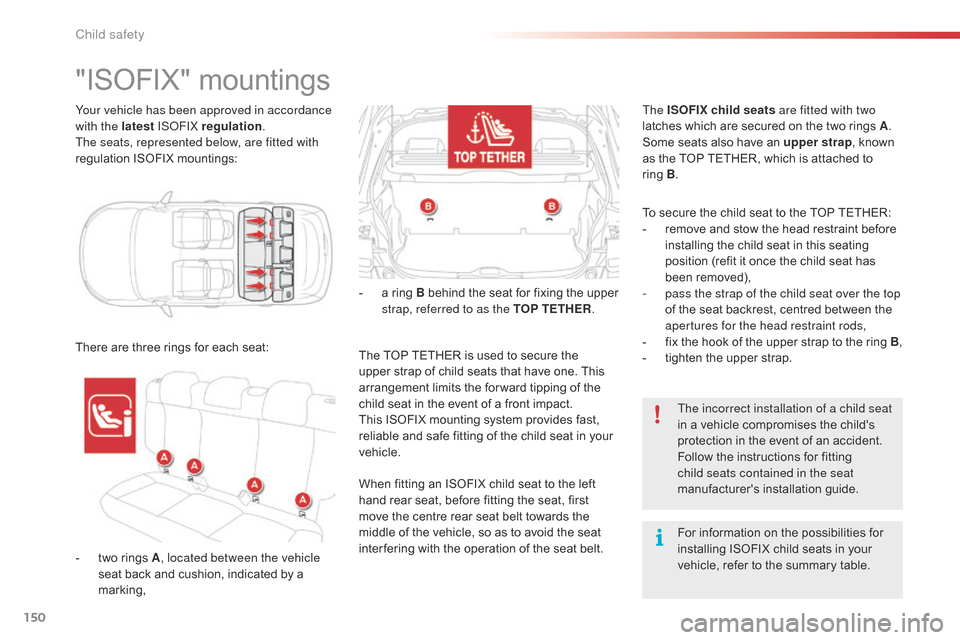
150
C4-cactus_en_Chap08_securite-enfants_ed02-2014
Your vehicle has been approved in accordance
with the latest ISoFI
X regulation.
The seats, represented below, are fitted with
regulation
I
SOFIX
m
ountings:
"ISOFIX" mountings
There are three rings for each seat: -
a
ring B behind the seat for fixing the upper
s
trap, referred to as the TOP TETHER
.
The TOP TETHER is used to secure the
u
pper strap of child seats that have one. This
a
rrangement limits the for ward tipping of the
c
hild seat in the event of a front impact.
This
ISOFIX mounting system provides fast,
r
eliable and safe fitting of the child seat in your
v
ehicle. For
information on the possibilities for
i
nstalling ISOFIX child seats in your
v
ehicle, refer to the summary table.
The incorrect installation of a child seat
in
a vehicle compromises the child's
p
rotection in the event of an accident.
Follow
the instructions for fitting
c
hild seats contained in the seat
manufacturer's
installation guide.
When
fitting an ISOFIX child seat to the left
h
and rear seat, before fitting the seat, first
m
ove the centre rear seat belt towards the
m
iddle of the vehicle, so as to avoid the seat
i
nter fering with the operation of the seat belt.The ISOFIX child seats are fitted with two
latches
which are secured on the two rings A
.
Some seats also have an upper strap
, known
a
s the TOP TETHER, which is attached to
r
ing B
.
To secure the child seat to the TOP TETHER:
-
r
emove and stow the head restraint before
i
nstalling the child seat in this seating
p
osition (refit it once the child seat has
b
een removed),
-
p
ass the strap of the child seat over the top
of the seat backrest, centred between the
a
pertures for the head restraint rods,
- f ix the hook of the upper strap to the ring B,
- t ighten the upper strap.
-
t
wo rings A, located between the vehicle
seat
back and cushion, indicated by a
m
arking,
Child safety
Page 154 of 326
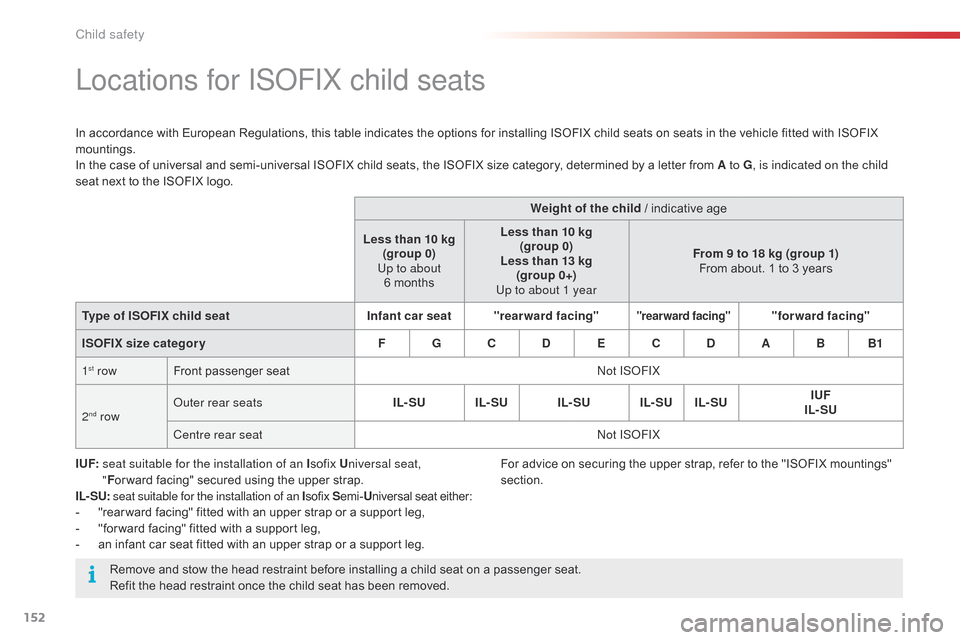
152
C4-cactus_en_Chap08_securite-enfants_ed02-2014
Locations for ISoFIX child seats
In accordance with European Regulations, this table indicates the options for installing ISOFIX child seats on seats in the vehicle fitted with ISOFIX m
ountings.
In
the case of universal and semi-universal ISOFIX child seats, the ISOFIX size category, determined by a letter from A to G, is indicated on the child
seat
next to the ISOFIX logo.
I UF:
s
eat suitable for the installation of an I sofix
Universal seat,
" F or ward facing"
secured using the upper strap.
IL- SU: seat suitable for the installation of an I sofix
Semi- Universal
sea
t
ei
ther:
-
"
rear ward facing" fitted with an upper strap or a support leg,
-
"
for ward facing" fitted with a support leg,
-
a
n infant car seat fitted with an upper strap or a support leg.Weight of the child
/ indicative age
Less than 10 kg (group 0)
Up to about 6 months Less than 10 kg
(group 0)
Less than 13 kg (group 0+)
Up to about 1 year From 9 to 18 kg (group 1)
From
about. 1 to 3 years
Type of ISOFIX child seat Infant car seat"rearward facing"
"rearward facing""forward facing"
ISOFIX size categor y F G C D E C D A B B1
1
st row Front p assenger sea tn ot ISo FIX
2
nd rowou ter rear seats
IL- SU IL- SU IL- SU IL- SU IL- SU IUF
IL- SU
Centre rear seat
n
ot IS
o
FIX
Remove
and stow the head restraint before installing a child seat on a passenger seat.
Refit
the head restraint once the child seat has been removed.For
advice on securing the upper strap, refer to the "ISOFIX mountings"
s
ection.
Child safety
Page 155 of 326
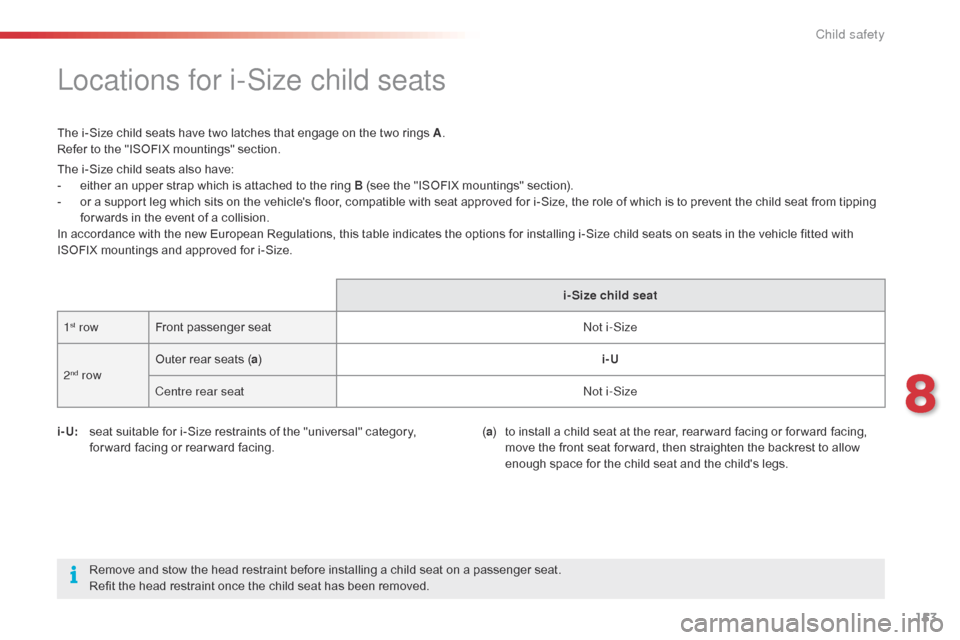
153
C4-cactus_en_Chap08_securite-enfants_ed02-2014
Locations for i-Size child seats
The i-Size child seats have two latches that engage on the two rings A.
R efer to the "ISOFIX mountings" section.
i- U:
s
eat suitable for i-Size restraints of the "universal" category,
f
or ward facing or rear ward facing.
Remove
and stow the head restraint before installing a child seat on a passenger seat.
Refit
the head restraint once the child seat has been removed.(
a )
t
o install a child seat at the rear, rear ward facing or for ward facing,
m
ove the front seat for ward, then straighten the backrest to allow
e
nough space for the child seat and the child's legs.
The
i-Size child seats also have:
-
e
ither an upper strap which is attached to the ring B (see the "ISOFIX mountings" section).
-
o
r a support leg which sits on the vehicle's floor, compatible with seat approved for i-Size, the role of which is to prevent the child seat from tipping
f
or wards in the event of a collision.
In
accordance with the new European Regulations, this table indicates the options for installing i-Size child seats on seats in the vehicle fitted with
I
SOFIX mountings and approved for i-Size. i-Size child seat
1
st row Front p assenger sea tno t i-Size
2
nd row Outer rear seats (
a ) i-U
Centre rear seatno t i-Size
8
Child safety
Page 156 of 326
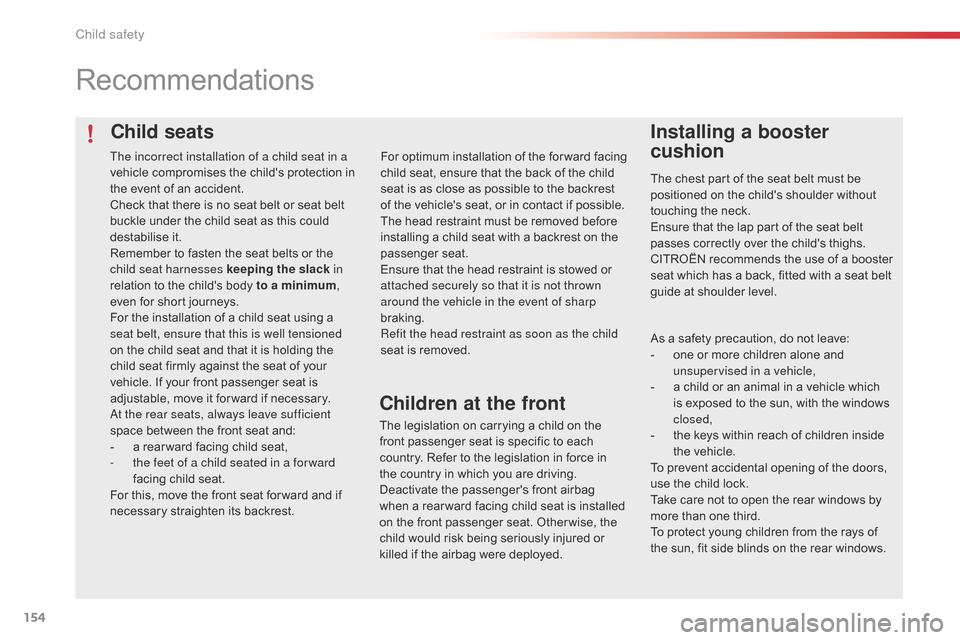
154
C4-cactus_en_Chap08_securite-enfants_ed02-2014
Child seats
Recommendations
Installing a booster
cushion
The chest part of the seat belt must be positioned on the child's shoulder without
t
ouching the neck.
Ensure
that the lap part of the seat belt
p
asses correctly over the child's thighs.
CITROËN
recommends the use of a booster
s
eat which has a back, fitted with a seat belt
g
uide at shoulder level.
As
a safety precaution, do not leave:
-
o
ne or more children alone and
u
nsupervised in a vehicle,
-
a
child or an animal in a vehicle which
i
s exposed to the sun, with the windows
c
losed,
-
t
he keys within reach of children inside
t
he vehicle.
To
prevent accidental opening of the doors,
u
se the child lock.
Take
care not to open the rear windows by
m
ore than one third.
To
protect young children from the rays of
t
he sun, fit side blinds on the rear windows.
Children at the front
For optimum installation o f t he fo rward f acing c
hild seat, ensure that the back of the child
s
eat is as close as possible to the backrest
o
f the vehicle's seat, or in contact if possible.
The
head restraint must be removed before
i
nstalling a child seat with a backrest on the
p
assenger
sea
t.
Ensure
that the head restraint is stowed or
a
ttached securely so that it is not thrown
around the vehicle in the event of sharp
braking.
Refit the head restraint as soon as the child
seat
is removed.
The
legislation on carrying a child on the
f
ront passenger seat is specific to each
c
ountry. Refer to the legislation in force in
t
he country in which you are driving.
Deactivate
the passenger's front airbag
w
hen a rear ward facing child seat is installed
o
n the front passenger seat. Other wise, the
c
hild would risk being seriously injured or
k
illed if the airbag were deployed.
The incorrect installation of a child seat in a
vehicle
compromises
the
child's
protection
in
t
he
event
of
an
accident.
Check
that
there
is
no
seat
belt
or
seat
belt
b
uckle
under
the
child
seat
as
this
could
de
stabilise
i
t.
Remember
to
fasten
the
seat
belts
or
the
c
hild seat harnesses keeping the slack in
relation
to
the
child's
body
to a minimum ,
even
for
short
journeys.
For
the
installation
of
a
child
seat
using
a
s
eat belt, ensure that this is well tensioned
on
the
child
seat
and
that
it
is
holding
the
c
hild
seat
firmly
against
the
seat
of
your
v
ehicle.
If
your
front
passenger
seat
is
a
djustable,
move
it
for ward
if
necessary.
at t
he rear seats, always leave sufficient
space
between
the
front
seat
and:
-
a
rear ward
facing
child
seat,
-
t
he feet of a child seated in a for ward
facing
child
seat.
For
this,
move
the
front
seat
for ward
and
if
n
ecessary
straighten
its
backrest.
Child safety
Page 158 of 326
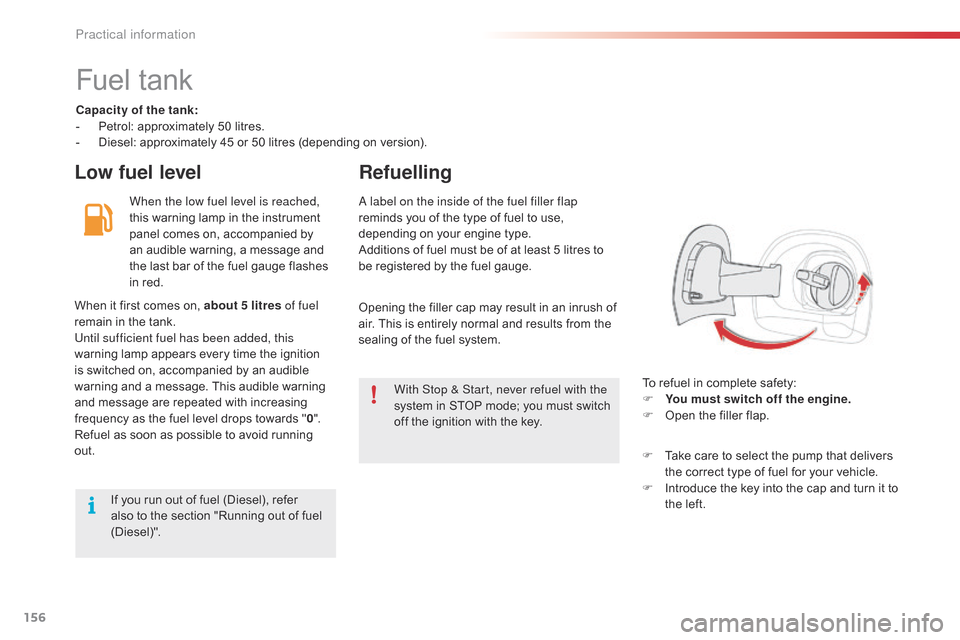
156
C4-cactus_en_Chap09_info-pratiques_ed02-2014
Fuel tank
Capacity of the tank:
- Pe trol: approximately 50 litres.
-
D
iesel: approximately 45 or 50 litres (depending on version).
Low fuel levelRefuelling
When the low fuel level is reached,
this
warning lamp in the instrument
p
anel comes on, accompanied by
a
n audible warning, a message and
t
he last bar of the fuel gauge flashes
i
n red.
To
refuel in complete safety:
F
Y
ou must switch off the engine.
F
O
pen the filler flap.a label on the inside of the fuel filler flap
reminds you of the type of fuel to use,
d
epending on your engine type.
Additions
of fuel must be of at least 5 litres to
b
e registered by the fuel gauge.
When
it
first comes on, about 5 litres of fuel
remain
in
the tank.
Until sufficient fuel has been added, this
warning
lamp appears every time the ignition
i
s
switched on, accompanied by an audible
w
arning
and a message. This audible warning
a
nd
message are repeated with increasing
f
requency
as the fuel level drops towards "0 ".
Refuel
as
soon as possible to avoid running
o
ut. Opening
the filler cap may result in an inrush of
a
ir. This is entirely normal and results from the
s
ealing of the fuel system.
With Stop & Start, never refuel with the
system
in STOP mode; you must switch
o
ff the ignition with the key.
If
you run out of fuel (Diesel), refer
a
lso to the section "Running out of fuel
(D
iesel)". F
T
ake care to select the pump that delivers
t
he correct type of fuel for your vehicle.
F
I
ntroduce the key into the cap and turn it to
t
he left.
Practical information
Page 171 of 326
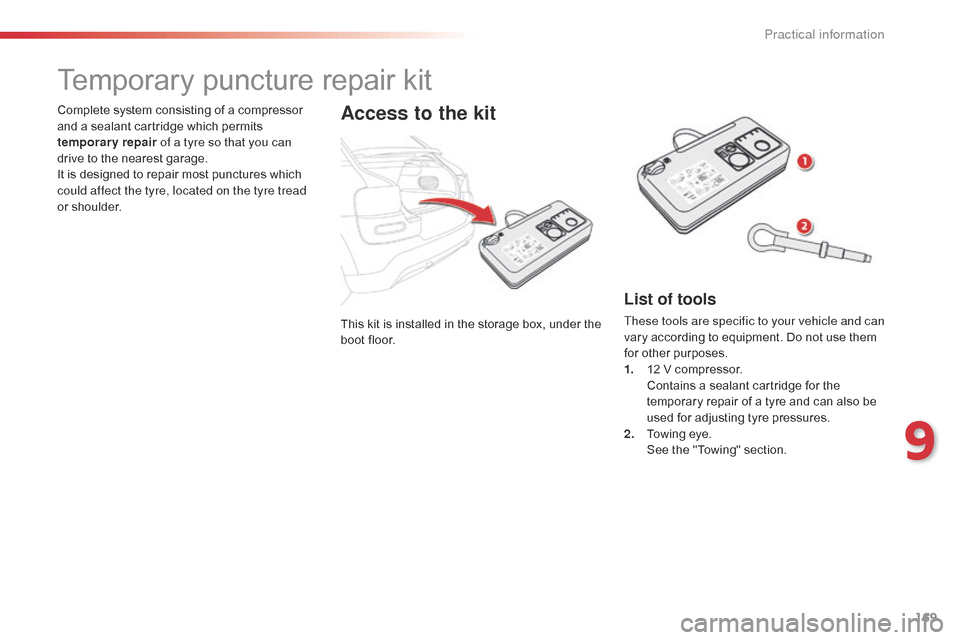
169
C4-cactus_en_Chap09_info-pratiques_ed02-2014
This kit is installed i n t he s torage b ox, u nder t he b
oot floor.
Complete
system
consisting
of
a
compressor
a
nd
a
sealant
cartridge
which
permits
t
emporary repair
of a tyre so that you can
drive
to
the
nearest
garage.
It
is
designed
to
repair
most
punctures
which
c
ould affect the tyre, located on the tyre tread
or
shoulder.
Temporary pu
ncture r epair k it
Access to the kit
List of tools
These tools are specific to your vehicle and can
vary
according to equipment. Do not use them
f
or other purposes.
1.
1
2 V compressor.
C
ontains a sealant cartridge for the
t
emporary repair of a tyre and can also be
u
sed for adjusting tyre pressures.
2.
T
owing eye.
S
ee the "Towing" section.
9
Practical information
Page 175 of 326
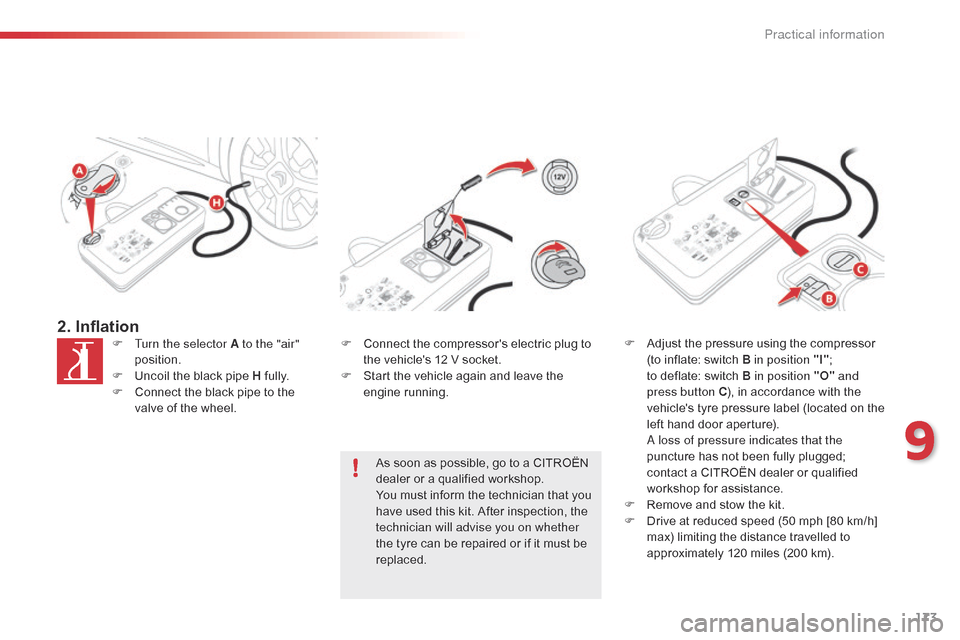
173
C4-cactus_en_Chap09_info-pratiques_ed02-2014
2. InflationF Turn the selector A to the "air" position.
F
U
ncoil the black pipe H
f
ully.
F
C
onnect the black pipe to the
v
alve of the wheel. F
C onnect the compressor's electric plug to t
he vehicle's 12 V socket.
F
S
tart the vehicle again and leave the
e
ngine
r
unning.
As
soon as possible, go to a CITROËN
d
ealer or a qualified workshop.
You
must inform the technician that you
h
ave used this kit. After inspection, the
t
echnician will advise you on whether
the
tyre can be repaired or if it must be
r
eplaced.F
A djust the pressure using the compressor (
to inflate: switch B in position "I";
t
o deflate: switch B in position "O" and
press button C ),
in accordance with the
v
ehicle's
t
yre pressure label (located on the
l
eft hand door aperture).
a
loss of pressure indicates that the
puncture
has not been fully plugged;
c
ontact a CITROËN dealer or qualified
w
orkshop for assistance.
F
R
emove and stow the kit.
F
D
rive at reduced speed (50 mph [80 km/h]
m
ax) limiting the distance travelled to
a
pproximately 120 miles (200 km).
9
Practical information